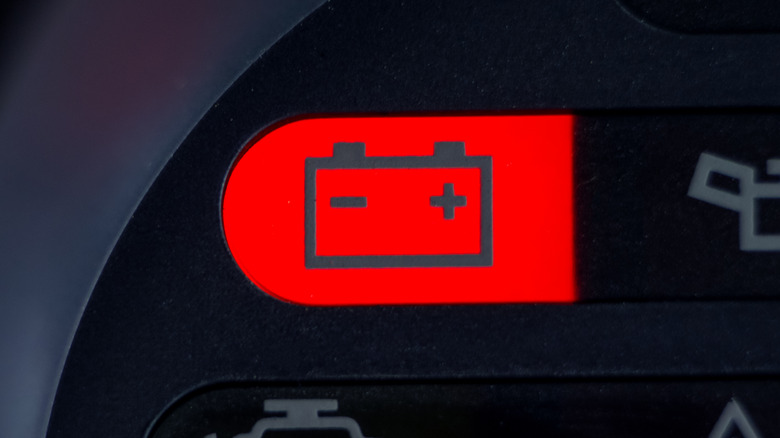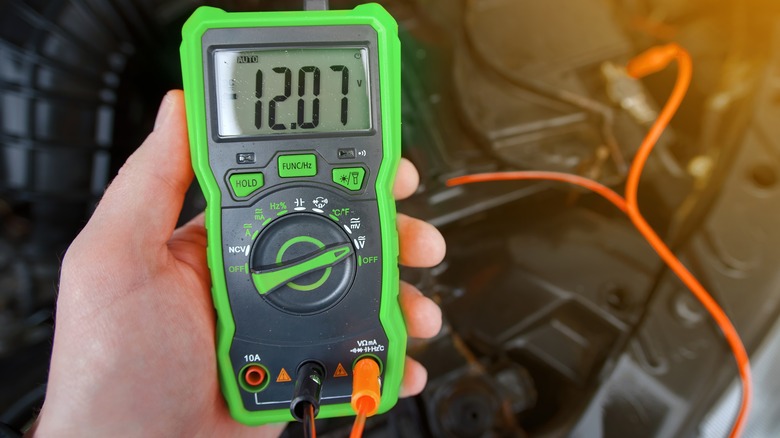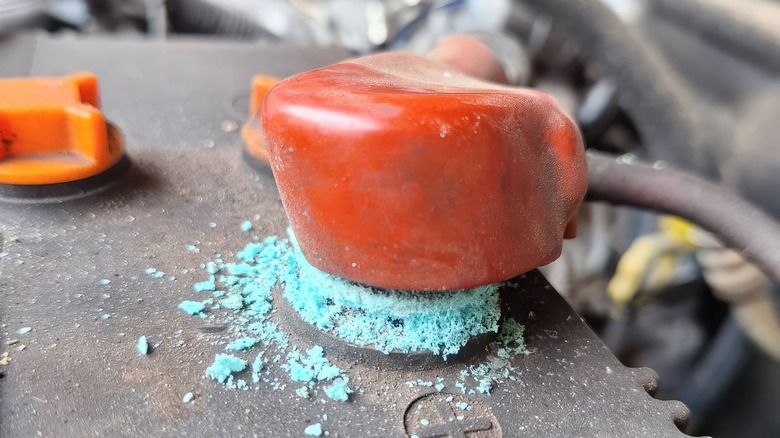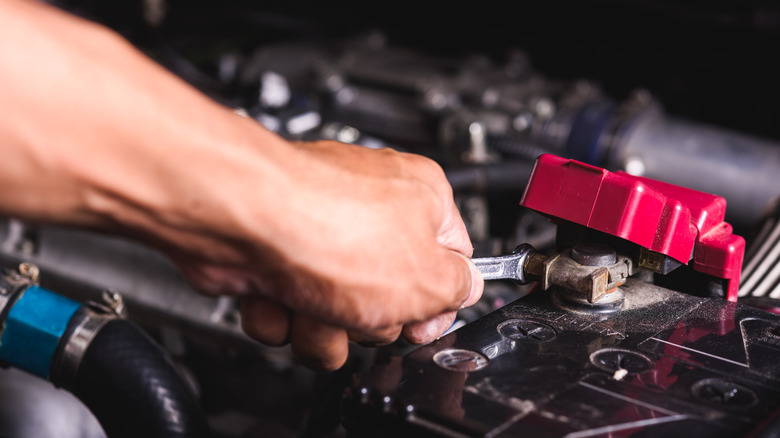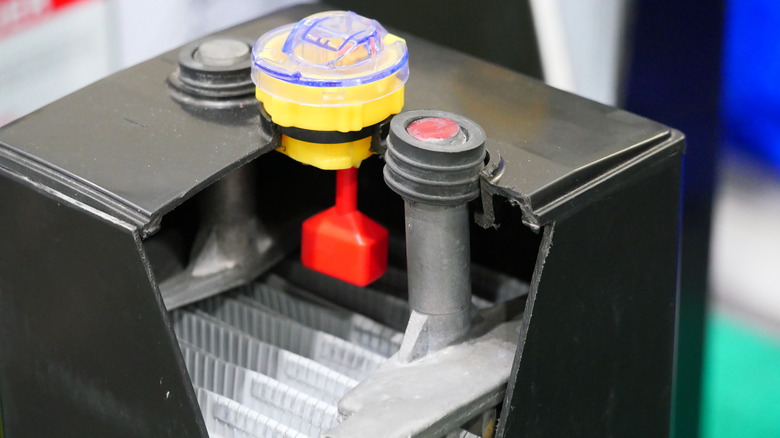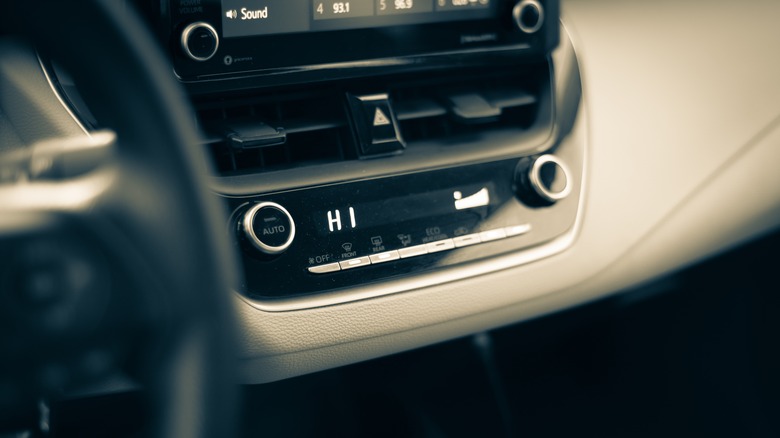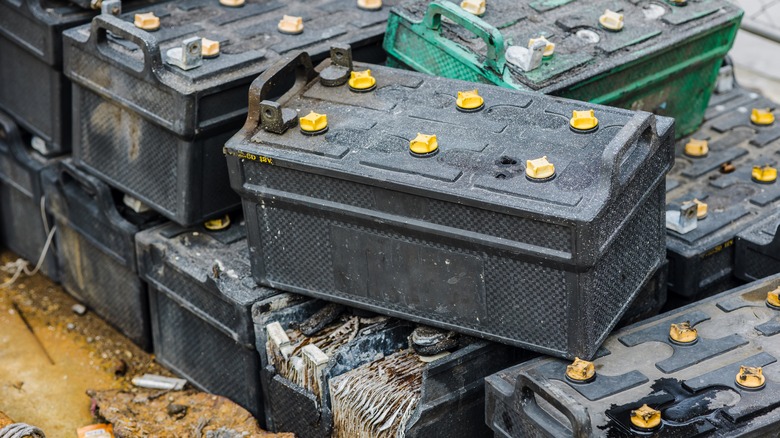6 Reasons Why The Battery Light On Your Dashboard Might've Come On
When you start your car, all of the lights on the dashboard flash on temporarily. Ideally, they'll all go off after a couple of seconds, but it can really dampen your day if one of those lights remains illuminated. The most common dashboard warning lights to be aware of and address immediately include the Check Engine, Brake System, and Coolant Level, and you especially don't want to overlook perhaps the most frightening warning signal of them all — the battery light.
It's possible the battery light in your car will turn on, and everything will seem fine. It may seem easy to ignore, particularly if you have somewhere important to be. But this is one warning you don't want to delay, as it's an indicator there's a problem with your vehicle's battery and/or charging system. Your battery isn't getting the proper amount of juice it needs, and the longer you drive with an issue, the greater the likelihood of the battery getting wiped out entirely.
Many people automatically assume they just need a new battery. While that's occasionally the case, it's a good idea to get your vehicle inspected by a professional to see if the problem lies tangential to that component. Car batteries usually last between three and five years, so if yours isn't at that point yet, there could be something else amiss. Here are the problems you might have when the battery light turns on, so no stone goes unturned.
Faulty alternator
Your car's battery doesn't produce power all by itself. The alternator is a critical component in your vehicle, as it takes chemical energy from the engine and transforms it into electrical energy to power your battery. In the event the alternator begins malfunctioning, your battery isn't going to receive the amount of power it needs, and the Battery light on your dashboard can turn on.
There are various ways to tell if your car's alternator is bad besides the dashboard indicator. You may notice rattling sounds coming from under the hood, and certain parts, like the headlights, may not receive enough juice to brighten fully. A good way to know for certain the alternator is to blame is to perform a voltage test, which any professional mechanic should accomplish if you don't feel comfortable doing it yourself. Ideally, the meter will be between 13.5 and 14.5 volts. Any higher or lower, and it's a marker of how your alternator is either overcharging or undercharging, respectively.
In either case, a bad alternator can damage the battery, resulting in cell failure within the device. Even if the battery is fairly new, you may need to replace both the alternator and the battery if you don't address the problem quickly enough. That's why you never want to ignore a dashboard signal; you could end up spending far more money to correct the issue than if you had simply dealt with it sooner.
Corroded terminals
This is an issue you should be able to assess on your own. Over time, green or white buildup can form around your vehicle's battery terminals, preventing the component from charging properly. This corrosion develops because it can get extremely hot underneath the hood, and the battery itself can leak hydrogen gas vapor. Combined with additional factors, such as heat radiating from the engine, it leads to the crusty-looking material.
Fortunately, this is one battery problem you might be able to address on your own, provided you understand how to proceed with all safety precautions. Coming into direct contact with corrosion can result in chemical burns (that's battery acid, after all). Make sure you wear eye protection and gloves so that you don't come into any direct contact with the corrosion. From there, you want to inspect the area to ensure the battery isn't leaking acid; otherwise, you will need to replace the whole thing.
You probably need to clean your car battery terminals regularly anyway to ensure the battery always gets a full charge. When cleaning is required, you can apply baking soda and water or a specialized battery cleaning spray. Use a wire brush or battery terminal brush to scrub at the terminals efficiently to remove that icky residue. When the terminals are too badly corroded, you may just need to replace them entirely, but hopefully, you can get to it soon enough to where it just needs some good scrubbing.
Loose cables
All that driving can do more than just irritate any passengers you have. The bumpiness can also cause various wiring under the hood to loosen, including the cables that are needed to adequately charge the battery. Another thing to inspect on your own is to make sure the cables are properly attached to the terminals. There shouldn't be any give when you wiggle the cables around, and if there is, you should tighten them right away so that your battery can once again receive a full charge.
The battery light on the dashboard isn't the only symptom of loose cables. You may notice you need to crank the ignition a few times to get your car actually going. Additionally, you may notice certain components aren't receiving as much power as they should, like your headlights beginning to dim haphazardly as you're driving. If not addressed promptly, loose cables can drain the battery and even cause your vehicle to lose power at random.
This is another issue that's easy to fix, so there's no reason to let your car battery get to the point where it's completely drained. Just tighten the cables. Should you still notice power issues, take your car to a mechanic. It's possible you just need new cables, but again, you don't want to wait even if the underlying problem seems minor.
Damaged cells
Most car batteries function via a collection of cells inside the casing, which convert the chemical energy into the electrical energy your car needs to function. All of the cells within the battery need to work for your vehicle to run smoothly, and you can tell there's a problem with at least one cell if you notice clicking sounds when you try to start your car, dimming headlights, or a slow crank.
After testing with a voltmeter to determine if the issue is indeed related to a cell, you might be able to repair it on your own. Each cell requires the proper amount of sulfuric acid and electrolyte, which you may be able to top off on your own, provided you understand what you're doing and know how to refill the cells safely in a well-ventilated area. You'll probably be better off taking your car to a professional to fix a cell, but it's important to know when to cut your losses.
For a standard car battery, it may cost the same to fix a single cell as to replace the whole battery, in which case you'd be better off just getting a new battery. However, replacing the battery for an electric or hybrid vehicle may cost thousands of dollars. In that case, it may be worth it to see if you can simply replace a cell.
Too many electrical devices in use
While standard car batteries should last at least a few years, you may wonder why your batteries die sooner than expected.There's a litany of factors to consider, but oftentimes, the answer is the simplest explanation — you're consistently putting too much strain on the battery by using electric devices too frequently. Many modern vehicles come with so many accessories, including lights, radio, AC, heated seats, and plenty of other features you may have added yourself. All of these require electricity, and using them too often, especially if the battery is already on its last legs, can result in premature failure.
When you're using too many features, it's possible the dashboard battery light will illuminate as a warning. You certainly want to inspect the terminals and cables to make sure the issue doesn't lie there. After you've exhausted all other options, it's paramount to consider your driving habits and if you can get by with fewer features going simultaneously.
In the event the battery light continues to elude you, you may want to consider whether any accessories were improperly wired. There are numerous benefits to adding Apple CarPlay to your ride, but incorrectly installing it can drain the battery faster. As always, let someone else handle the Apple CarPlay installation if you don't feel confident in your own abilities.
Old battery
After exhausting all other possibilities, it may simply be time to get a new battery. Most batteries last three to five years, while some can last up to six. Depending on your driving habits, it's possible your battery will only last a year or two.
The question many people undoubtedly have is how long they can drive once that dashboard battery light shines on. As is the case with any dashboard light, the sooner you can address the problem, the better off you'll be. However, there are special considerations to make with the battery light, as you may only have 20 to 30 minutes to get your car to an auto shop to see what the problem might be. Your car can't run if the battery fails completely, and you don't want to run out of power when you're in the middle of the freeway.
You may be able to contact a driving service to give you a jump-start so that you can drive your car yourself to a mechanic. However, depending on the battery's condition, a jump may not get you very far, and you'll need a tow to get where you're heading. It's best to simply see a professional as soon as you see the light turn on. It'll save you some hassle, and you may not have to spend as much if you can at least salvage the battery while replacing something else.
